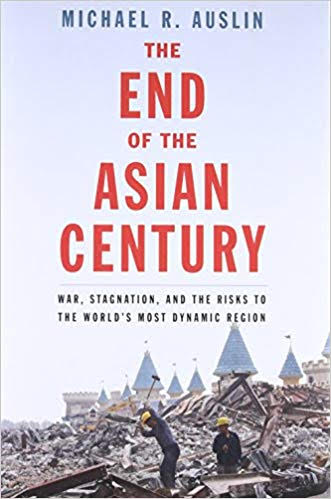"The End of the Asian Century" - Michael Auslin

Above: "The End of the Asian Century" - Michael R. Auslin. 222 Pages.
From China’s slumping economy to war clouds over the South China Sea and from environmental devastation to demographic crisis, Auslin says Asia’s future is uncertain.
I completed reading this book today. Author, Auslin distributed the book to attendees of his speech, including me, on the book's topic at the fall retreat of the Hoover Institution, in Palo Alto, CA, November 2018. Auslin is a former Yale history professor and current Hoover Institution Fellow.
I have work experience in Asia.
From 1982 to 1985 I headed a finance company subsidiary of Citigroup based in Tokyo, Japan, "CCKK." Japan was on a roll in those days. The favored book to read, and I read it at the time, was "MITI and the Modern Japanese Miracle," by Chalmers Johnson.
It was conventional wisdom during the late '70's to the mid-80's, certified in Johnson's book, that Japan would shortly become the world's leading economy. Japanese businesses, it was said, were the world's leaders in lowering manufacturing costs while improving quality of sophisticated products... like computers, autos, and electronics. Japan had turned its economy into a mega export engine and was entertaining economic growth rates approaching double digits.
Ten years later, Japan had stalled out. Recession had occurred, but, Japan had not figured out a way to reenergize its growth. Japan accumulated large amounts of debt. Today's indebtedness exceeds 200% of GDP, more than double the rate of indebtedness of the United States. Debt payments crowd out and depress otherwise legitimate economic activity.
Gone is Japan's vaunted life time employment. The Fukushima nuclear plant disaster has resulted in energy costs that are fifty percent higher than before the tsunami. It's difficult to fire anyone in Japan. Women are absent from the work force at rates that far exceed other developed countries. Japan has a whopping $2.5 trillion in unused liquidity. Japan has a demographic problem with its aging population. Yet. Japan hasn't yet figured out a way to continue its economic growth using foreign workers.
Its hard to see, notwithstanding Abenomics, a way for Japan to resume the growth rates it enjoyed in the early 80's... without major structural reform and relaxed requirements on absorbing foreign workers and managers.
And so, says Michael Auslin, is China, like Japan before it, fraught with risks that could easily derail her expected achievement of world economic, cultural and political supremacy.
Like Japan, China also has demographic problems. First, her population is aging... but, also the one child policy instituted during Mao's regime (since reversed) means that there is a paucity of working age Chinese citizens coming through the pipeline to fill new jobs that can sustain high growth rates.
Moreover, there is a male/female gap. Because, under the one child policy many families elected to abort females, there is a shortage of females relative to comparable aged men, estimated by some to be as high as 300 million. Many fear serious social unrest pursuant to this gender imbalance.
As a percent of its total economy China has a disproportionately high percentage of state owned enterprises (SOE's), Because of intrusive government resource allocation arising from SOE's, in real estate, for example, we are left with China's ghost cities... empty high rises and shopping centers awaiting residents who had been expected to migrate from the country to the cities.
The ghost cities are financed by bank loans with no perceptible source of repayment... China's banking system must carry or eat the debt... either way, this is not a good sign for Chinese banks to be other than a drag on the Chinese GDP growth rate.
China has many unfair tariff barriers and non tariff barriers.
China has been identified as a major cyber war player and is credibly accused of stealing foreign technology.
From China’s slumping economy to war clouds over the South China Sea and from environmental devastation to demographic crisis, Auslin says Asia’s future is uncertain.
Auslin argues that far from being a cohesive powerhouse, Asia is a fractured region threatened by stagnation and instability.
In his book, Auslin delineates the the economic, military, political, and demographic risks that could derail the Asian and Chinese growth engine.
Auslin believes that the United States has a key role to play if catastrophe is to be averted, but only if it acts boldly.
Before accepting conventional wisdom on Chinese emergence as the world's preeminent economic power, reading this book is advised.